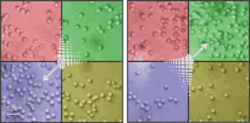
Named after the famous British astronomer Sir George Airy, the Airy beam does not diffract or spread and can actually bend or curve as it propagates; in 2007, Airy light beams were demonstrated by a research team at the University of Central Florida.1 The first practical application for such beams has now been developed by researchers in the School of Physics and Astronomy at the University of St. Andrews (Fife, Scotland): moving particles in a curved path within Airy light beams, offering a new method for optical manipulation of particles for microfluidic engineering and cell-biology applications.2
“This challenges our thoughts of how light propagates and may open up applications for controllably repositioning or distributing colloid or cells within compartments in a microfluidic environment,” says Joerg Baumgartl, one of the researchers. “It is exciting to see a synergy between quantum mechanics and optical physics exploited in this way.”
“Physics holds many surprises; our understanding of how light moves and behaves is challenged by such beams and it is exciting to see them move into the interdisciplinary arena–light has thrown us a curve ball!” says Kishan Dholakia, another researcher.
The researchers used a spatial light modulator to create a finite two-dimensional (2-D) Airy beam through cubic phase modulation of a Gaussian 514 nm argon-laser light source. This beam was then Fourier-transformed by a spherical lens to create the desired Airy beam. Inverse telescope optics reduced the beam size by a factor of approximately 100 µm to a typical size of 10 µm in the transverse direction. The 2-D Airy beam has a main spot and a number of side lobes that decay in intensity outward from the main spot according to an exponentially truncated Airy-function equation; the Airy beam is capable of exerting an optical gradient force on dielectric particles and can drag the particles toward the main intensity spot.
Light trap
In a demonstration of particle manipulation, an Airy beam illuminates a suspension of 1.5-µm-diameter colloidal glass spheres from below the sample. The intensity of the Airy source is approximately 25 mW at the sample plane, and the Airy beam is imaged into the sample plane and then propagates approximately 75 µm. The initially homogeneous mixture, after two minutes of Airy-beam exposure, becomes highly asymmetric–in effect, particles are pulled by the outer lobes of the Airy beam toward its main spot, essentially clustering the particles toward one end of the sample area (see figure). If the directionality of the Airy beam is rotated 180°, the colloidal particles are then redirected to the other side of the sample area. If the size of the Airy beam is reduced, the acceleration of the particles is increased.
While investigating particle manipulation, the research team also observed that Airy beams, like Bessel beams, exhibit an automatic healing behavior. In the presence of an obstruction of the Airy Beam the intensity field is initially blocked, but then gradually reappears while propagating past the obstructed area.
The manipulation of particles along a parabolic path using Airy beams holds promise for particle sorting and mixing without complex beam motion.
REFERENCES
- G.A. Siviloglou et al., Phys. Rev. Lett. 99, 213901 (2007).
- J. Baumgartl et al., Nature Photonics online, doi:10.1038/nphoton.2008.201 (Sept. 28, 2008).
About the Author

Gail Overton
Senior Editor (2004-2020)
Gail has more than 30 years of engineering, marketing, product management, and editorial experience in the photonics and optical communications industry. Before joining the staff at Laser Focus World in 2004, she held many product management and product marketing roles in the fiber-optics industry, most notably at Hughes (El Segundo, CA), GTE Labs (Waltham, MA), Corning (Corning, NY), Photon Kinetics (Beaverton, OR), and Newport Corporation (Irvine, CA). During her marketing career, Gail published articles in WDM Solutions and Sensors magazine and traveled internationally to conduct product and sales training. Gail received her BS degree in physics, with an emphasis in optics, from San Diego State University in San Diego, CA in May 1986.